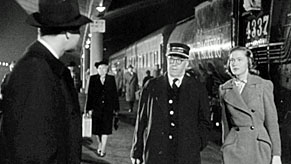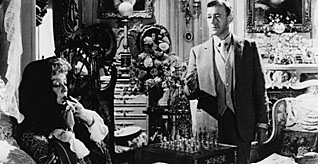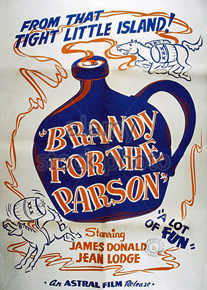REVIEWED BY DAVID VINEYARD:
BRANDY FOR THE PARSON. Associated British-Pathé, UK, 1952. James Donald, Kenneth More, Jean Lodge, Charles Hawtry, Frederick Piper, Michael Trubshaw, Reginald Beckwith, Alfie Bass, Arthur Wotner . Screenplay by Walter Meade and John Dighton, based on the short story by Geoffrey Household. Directed by John Eldridge.
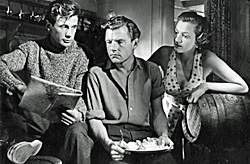
If you only know Geoffrey Household from his classic novels of chase and pursuit like Rogue Male, Watcher in the Shadows, and A Rough Shoot, you may be surprised to find this droll comedy is based on one of his better known short stories. Then again if you have read his picaresque adventure stories like Fellow Traveler and The Life and Times of Bernardo Brown you may be better prepared for the film based on his tale.
Bill Harper (James Donald) works a rather dull job in London, all bowler hats and umbrellas, but he and his fiancée Petronella Brand (Jean Lodge) are off for a week of sailing to escape all that. After a crowded train and a pouring rain they finally are off, sailing out the channel, Petronella at the helm, Bill guiding her — and staring off into space when they crash right into a motor launch when Petronella doesn’t know port from starboard.
Tony Rackham (Kenneth More) is the fellow piloting the launch, a likable enough chap who has a bit of a problem, he has to get to France to pick up a package for delivery.
And charming fellow that he is he doesn’t bother to mention he is delivering smuggled brandy.
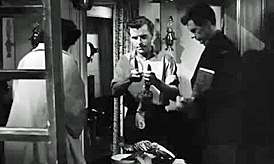
The British have always had a unique view of smuggling and avoiding excise taxes dating back to the exploits of Dr. Syn, the Scarecrow, not to mention the people smuggled out of France by the Scarlet Pimpernel. It has always had the aspect of a game, and in the Post-War period when England was suffering shortages and paying high taxes on imported alcohol, the public was clearly on the side of the smugglers, as witness films such as Whiskey Galore (based on the novel by Compton Mackenzie), Green Grow the Rushes, and Law and Disorder. Like the poaching in John Buchan’s John Macnab, it was all good sport.
After a series of misadventures Bill and Petronella get rid of Tony and his barrels of brandy, only to find a Customs Inspector (Frederick Piper) nosing around, so in a panic they go back and with the help of a group of cub scouts move the brandy just as Tony shows up with his reluctant friend George Grump (bespectacled comic actor Charles Hawtry) in a laundry truck to take the stuff to London.
The four meet up, determined to get the stuff to London so Bill and Petronella can be rid of it and Tony, but the Customs Inspector is close behind and they have no way to move the barrels. A passing circus provides a partial answer, but they are still fifty miles short of their goal and need transport, and by now the roads are all watched, which is how Tony comes to buy circus ponies and decides to transport the brandy cross country along the Appian Way, the old Roman road.
And soon enough, Tony is off to London to arrange to pick the brandy up at a rendezvous while Bill, Petronella, and George are roughing it across country pursued by Customs.
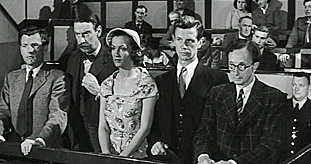
Brandy for the Parson is a quiet comedy, most of the laughs are gentle, and being based on a story by Geoffrey Household there is a real feeling for being pursued across rough country. Everything works out, but only just, and Tony gets to deliver the last line assuring us that some crime does pay, or at least for him.
A veteran cast of newer stars like Donald, More, Lodge, and Hawtry, along with old-timers and veteran British character actors enliven the tale with charm and style. Unlike too many American comedies of the era, this one is satisfied to tell the story in straightforward manner with no forced slapstick or silly business. The humor arises from the characters and their plight and is never forced or phony. Everyone here is attractive and smart save poor Hawtry who discovers along the way he is not a true teetotaler
Donald shows that he should have been used more often in comedy, while Lodge is both attractive and bright. More always exuded charm with that smile and this is no exception.
Michael Trubshaw has a good bit as a well-to-do farmer who wants to form a syndicate to buy the smuggled brandy so it isn’t wasted on the wine shop in London where it will be sold to snobs, and Arthur Wotner of Sherlock Holmes fame, has a small but key role as Major Goodleigh who saves our heroes from themselves.
Brandy for the Parson is handsome to look at and an intelligent and funny tale in the mode of Geoffrey Household’s better known works. The story appears in Tales of Adventurers (Joseph, 1952) among the collections of Household’s short stories. Both it and the film are well worth looking up.

